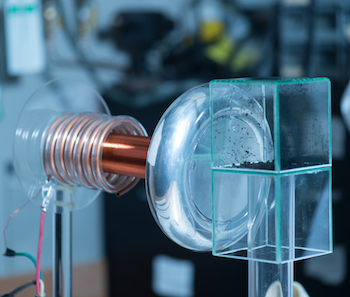
A Tesla coil can force nanotubes to self-assemble into long wires
The Tesla coil invented by none other than Nikola Tesla around the year 1891 is used to produce high-voltage, low-current, and high-frequency AC electricity. Tesla experimented a lot with the coil in different configurations.
Now, scientists from Rice University are experimenting with the coil, too, and they’ve discovered that the strong force field emitted by a Tesla coil can actually causes carbon nanotubes to self-assemble into long wires — a phenomenon they call “Teslaphoresis.”
Rice University’s system works by remotely oscillating positive and negative charges in each nanotube, which result in them chaining together into long wires. Rice chemist Paul Cherukuri specially designed the Tesla coil to generate a tractor beam-like effect as nanotube wires are pulled toward the coil over long distances.
“Electric fields have been used to move small objects, but only over ultrashort distances,” said Cherukuri. “With Teslaphoresis, we have the ability to massively scale up force fields to move matter remotely.”This force-field effect on matter had never been observed on such a large scale, Cherukuri said, and the phenomenon was unknown to Nikola Tesla, who invented the coil in 1891 with the intention of delivering wireless electrical energy.

It turns out that the phenomenon simultaneously assembles and powers circuits that harvest energy from the field. In one of the team’s experiments, the nanotubes assembled themselves into wires, formed a circuit connecting two LEDs and then absorbed energy from the Tesla coil’s field to light them.
By re-designing the Tesla coil, Cherukuri realized that he could create a powerful force field at distances greater than anyone imagined.
Currently, the directed force field from the bench-top coil used at Rice is restricted to just a few feet, but larger systems are being developed to determine the effects on matter at greater distances.
While nanotubes were the team’s first test material, the researchers envision many other nanomaterials can be assembled as well.
“There are so many applications where one could utilize strong force fields to control the behavior of matter in both biological and artificial systems,” said Cherukuri. “And even more exciting is how much fundamental physics and chemistry we are discovering as we move along. This really is just the first act in an amazing story.”
Learn more about the coil at Rice University.

Comments are closed, but trackbacks and pingbacks are open.